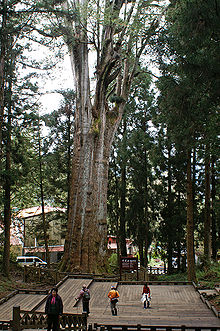Chamaecyparis formosensis
| Chamaecyparis formosensis | |
|---|---|

| |
| Scientific classification | |
| Kingdom: | Plantae |
| Clade: | Tracheophytes |
| Clade: | Gymnospermae |
| Division: | Pinophyta |
| Class: | Pinopsida |
| Order: | Cupressales
|
| Family: | Cupressaceae |
| Genus: | Chamaecyparis |
| Species: | C. formosensis
|
| Binomial name | |
| Chamaecyparis formosensis | |
Chamaecyparis formosensis (Formosan cypress, Taiwan cypress, Taiwan red cypress;
Growth
It is a slow-growing, but long-lived and ultimately large to very large
-
Stringy bark.
-
Foliage and pollen cones.
Related species
It is most closely related to the Japanese Chamaecyparis pisifera (sawara cypress), which differs in smaller globose cones 4–8 mm long with 6–10 scales.[2]
Characteristics
The wood is soft, very resistant to decay, and strongly scented; it is highly valued in traditional Taiwanese building, particularly for temples and shrines. This has led to excessive harvesting, resulting in the species now being endangered. A small number of the oldest and largest specimens are protected as national monuments, but much of the general population of the species still remains unprotected.[2]
Essential oil distilled from its wood is uniquely scented and highly valued.[4]
Notable examples
Sacred Tree of Alishan
The Sacred Tree of Alishan was a 3,000-year-old Taiwan red cypress which died from a lightning strike in 1956. The trunk remained standing until 1998. Due to its sacred status it was left alone by the Japanese when they deforested the surrounding area.[5]
References
- ^ . Retrieved 17 November 2021.
- ^ ISBN 1-84246-068-4.
- ^ Flora of China: Chamaecyparis formosensis
- ^ Su, Sharleen. "Distilling Taiwan's Native Scent". www.taiwan-panorama.com. Taiwan Panorama. Retrieved 16 December 2020.
- ^ Cheung, Han (26 June 2022). "Taiwan inTime: Farewell to the divine giant". taipeitimes.com. Taipei Times. Retrieved 28 June 2022.



